Strategic Management : Analysis of Lidl
VerifiedAdded on 2022/09/01
|17
|5001
|29
AI Summary
Contribute Materials
Your contribution can guide someone’s learning journey. Share your
documents today.
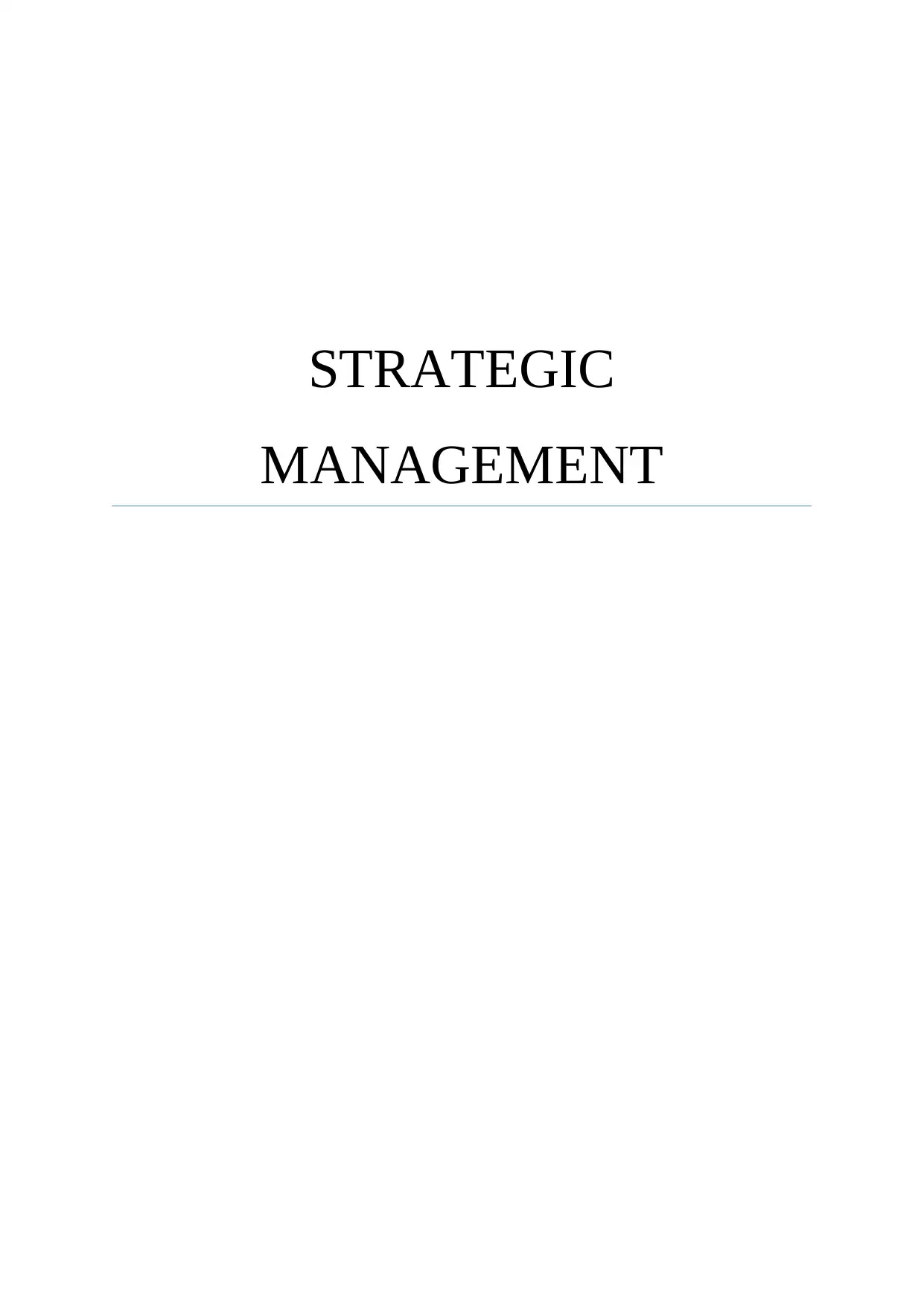
STRATEGIC
MANAGEMENT
MANAGEMENT
Secure Best Marks with AI Grader
Need help grading? Try our AI Grader for instant feedback on your assignments.
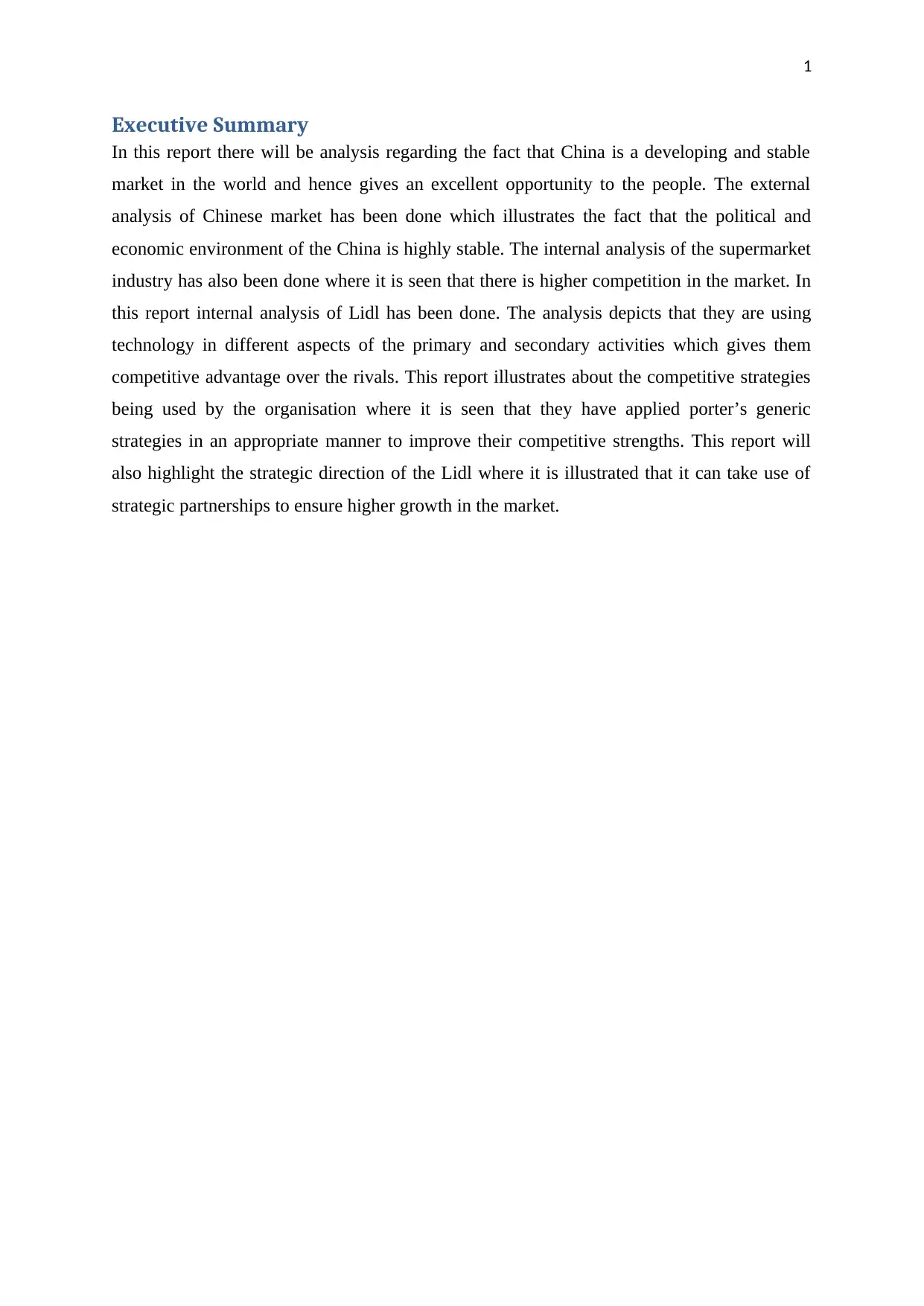
1
Executive Summary
In this report there will be analysis regarding the fact that China is a developing and stable
market in the world and hence gives an excellent opportunity to the people. The external
analysis of Chinese market has been done which illustrates the fact that the political and
economic environment of the China is highly stable. The internal analysis of the supermarket
industry has also been done where it is seen that there is higher competition in the market. In
this report internal analysis of Lidl has been done. The analysis depicts that they are using
technology in different aspects of the primary and secondary activities which gives them
competitive advantage over the rivals. This report illustrates about the competitive strategies
being used by the organisation where it is seen that they have applied porter’s generic
strategies in an appropriate manner to improve their competitive strengths. This report will
also highlight the strategic direction of the Lidl where it is illustrated that it can take use of
strategic partnerships to ensure higher growth in the market.
Executive Summary
In this report there will be analysis regarding the fact that China is a developing and stable
market in the world and hence gives an excellent opportunity to the people. The external
analysis of Chinese market has been done which illustrates the fact that the political and
economic environment of the China is highly stable. The internal analysis of the supermarket
industry has also been done where it is seen that there is higher competition in the market. In
this report internal analysis of Lidl has been done. The analysis depicts that they are using
technology in different aspects of the primary and secondary activities which gives them
competitive advantage over the rivals. This report illustrates about the competitive strategies
being used by the organisation where it is seen that they have applied porter’s generic
strategies in an appropriate manner to improve their competitive strengths. This report will
also highlight the strategic direction of the Lidl where it is illustrated that it can take use of
strategic partnerships to ensure higher growth in the market.
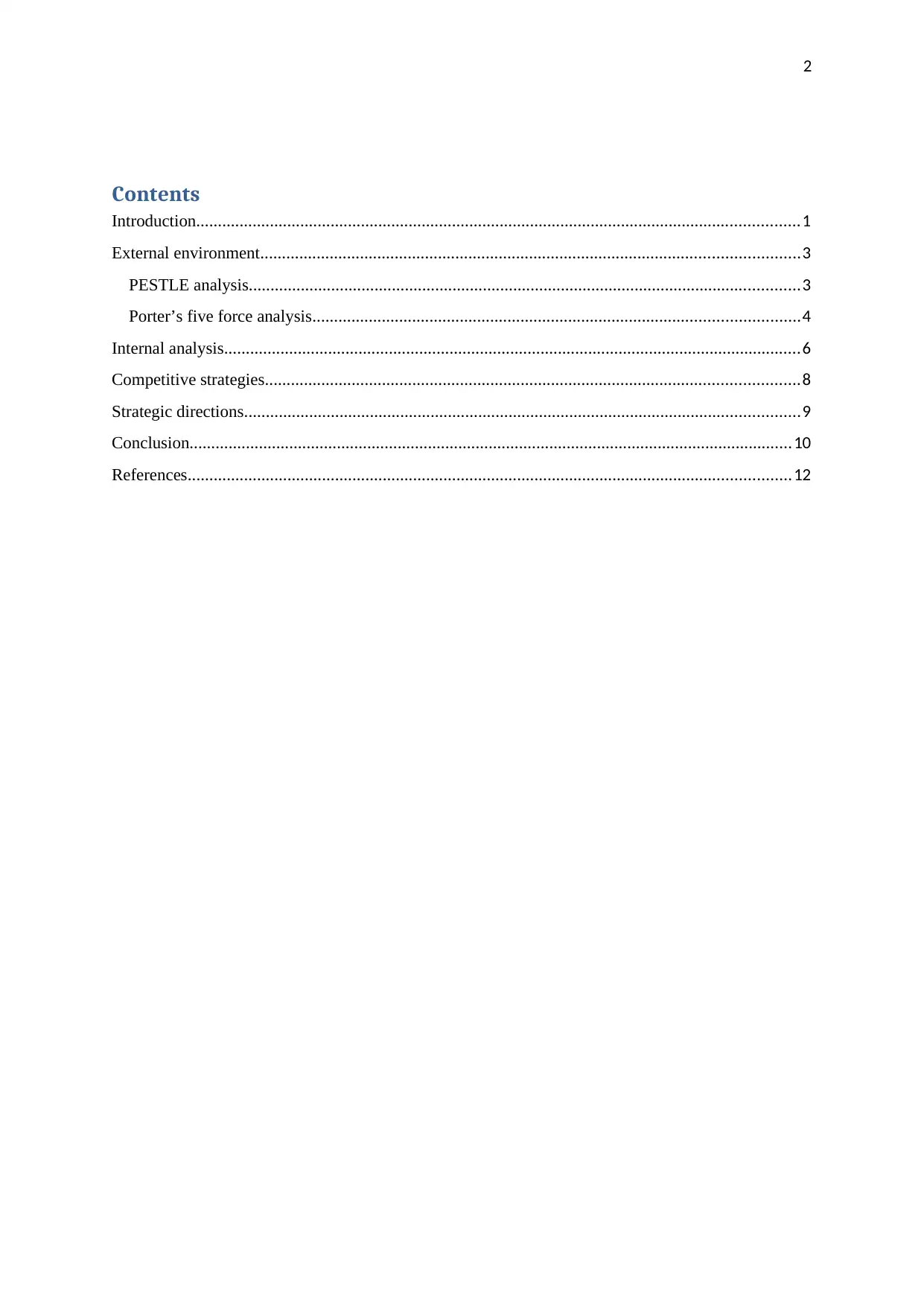
2
Contents
Introduction...........................................................................................................................................1
External environment............................................................................................................................3
PESTLE analysis...............................................................................................................................3
Porter’s five force analysis................................................................................................................4
Internal analysis.....................................................................................................................................6
Competitive strategies...........................................................................................................................8
Strategic directions................................................................................................................................9
Conclusion...........................................................................................................................................10
References...........................................................................................................................................12
Contents
Introduction...........................................................................................................................................1
External environment............................................................................................................................3
PESTLE analysis...............................................................................................................................3
Porter’s five force analysis................................................................................................................4
Internal analysis.....................................................................................................................................6
Competitive strategies...........................................................................................................................8
Strategic directions................................................................................................................................9
Conclusion...........................................................................................................................................10
References...........................................................................................................................................12
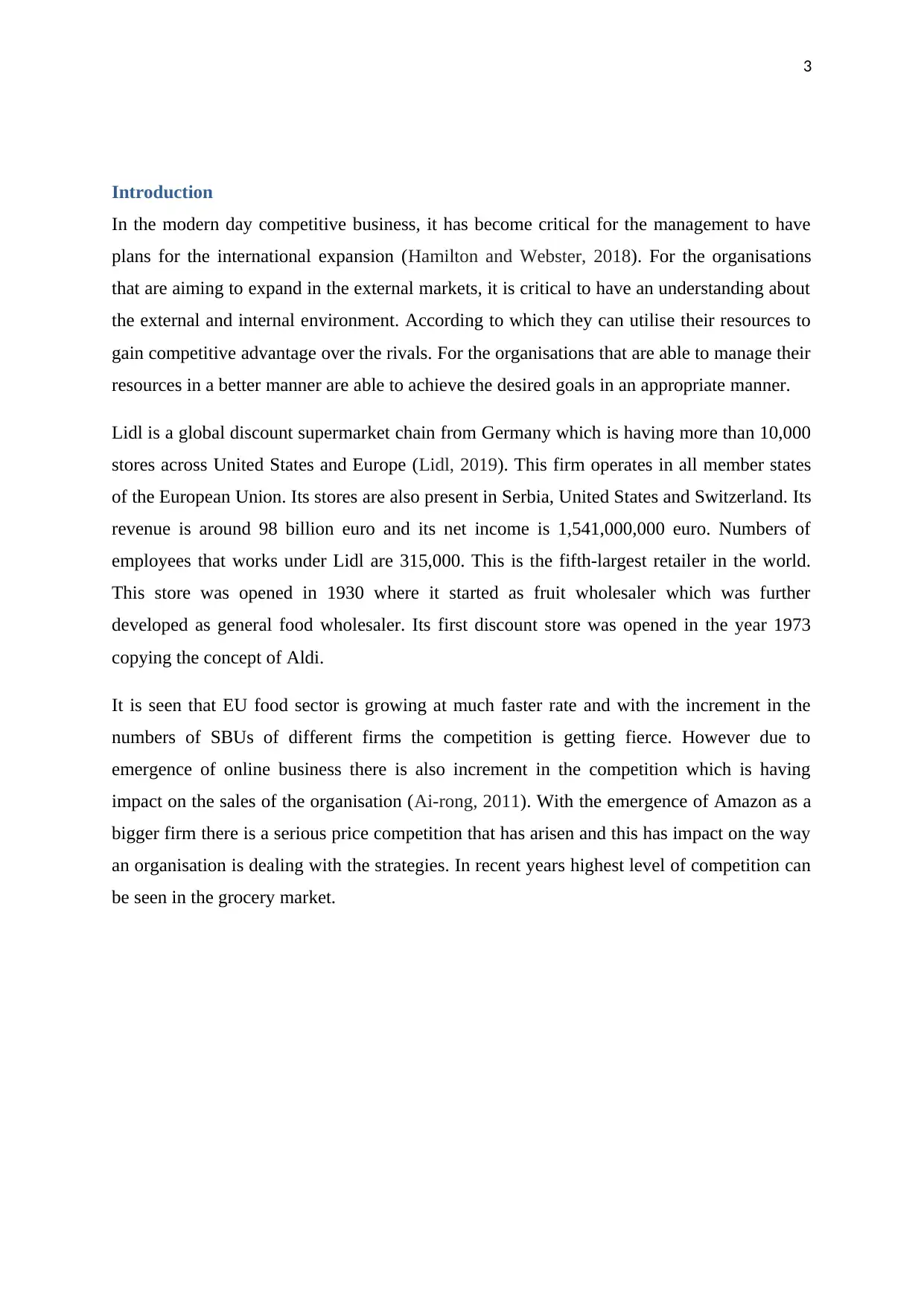
3
Introduction
In the modern day competitive business, it has become critical for the management to have
plans for the international expansion (Hamilton and Webster, 2018). For the organisations
that are aiming to expand in the external markets, it is critical to have an understanding about
the external and internal environment. According to which they can utilise their resources to
gain competitive advantage over the rivals. For the organisations that are able to manage their
resources in a better manner are able to achieve the desired goals in an appropriate manner.
Lidl is a global discount supermarket chain from Germany which is having more than 10,000
stores across United States and Europe (Lidl, 2019). This firm operates in all member states
of the European Union. Its stores are also present in Serbia, United States and Switzerland. Its
revenue is around 98 billion euro and its net income is 1,541,000,000 euro. Numbers of
employees that works under Lidl are 315,000. This is the fifth-largest retailer in the world.
This store was opened in 1930 where it started as fruit wholesaler which was further
developed as general food wholesaler. Its first discount store was opened in the year 1973
copying the concept of Aldi.
It is seen that EU food sector is growing at much faster rate and with the increment in the
numbers of SBUs of different firms the competition is getting fierce. However due to
emergence of online business there is also increment in the competition which is having
impact on the sales of the organisation (Ai-rong, 2011). With the emergence of Amazon as a
bigger firm there is a serious price competition that has arisen and this has impact on the way
an organisation is dealing with the strategies. In recent years highest level of competition can
be seen in the grocery market.
Introduction
In the modern day competitive business, it has become critical for the management to have
plans for the international expansion (Hamilton and Webster, 2018). For the organisations
that are aiming to expand in the external markets, it is critical to have an understanding about
the external and internal environment. According to which they can utilise their resources to
gain competitive advantage over the rivals. For the organisations that are able to manage their
resources in a better manner are able to achieve the desired goals in an appropriate manner.
Lidl is a global discount supermarket chain from Germany which is having more than 10,000
stores across United States and Europe (Lidl, 2019). This firm operates in all member states
of the European Union. Its stores are also present in Serbia, United States and Switzerland. Its
revenue is around 98 billion euro and its net income is 1,541,000,000 euro. Numbers of
employees that works under Lidl are 315,000. This is the fifth-largest retailer in the world.
This store was opened in 1930 where it started as fruit wholesaler which was further
developed as general food wholesaler. Its first discount store was opened in the year 1973
copying the concept of Aldi.
It is seen that EU food sector is growing at much faster rate and with the increment in the
numbers of SBUs of different firms the competition is getting fierce. However due to
emergence of online business there is also increment in the competition which is having
impact on the sales of the organisation (Ai-rong, 2011). With the emergence of Amazon as a
bigger firm there is a serious price competition that has arisen and this has impact on the way
an organisation is dealing with the strategies. In recent years highest level of competition can
be seen in the grocery market.
Secure Best Marks with AI Grader
Need help grading? Try our AI Grader for instant feedback on your assignments.
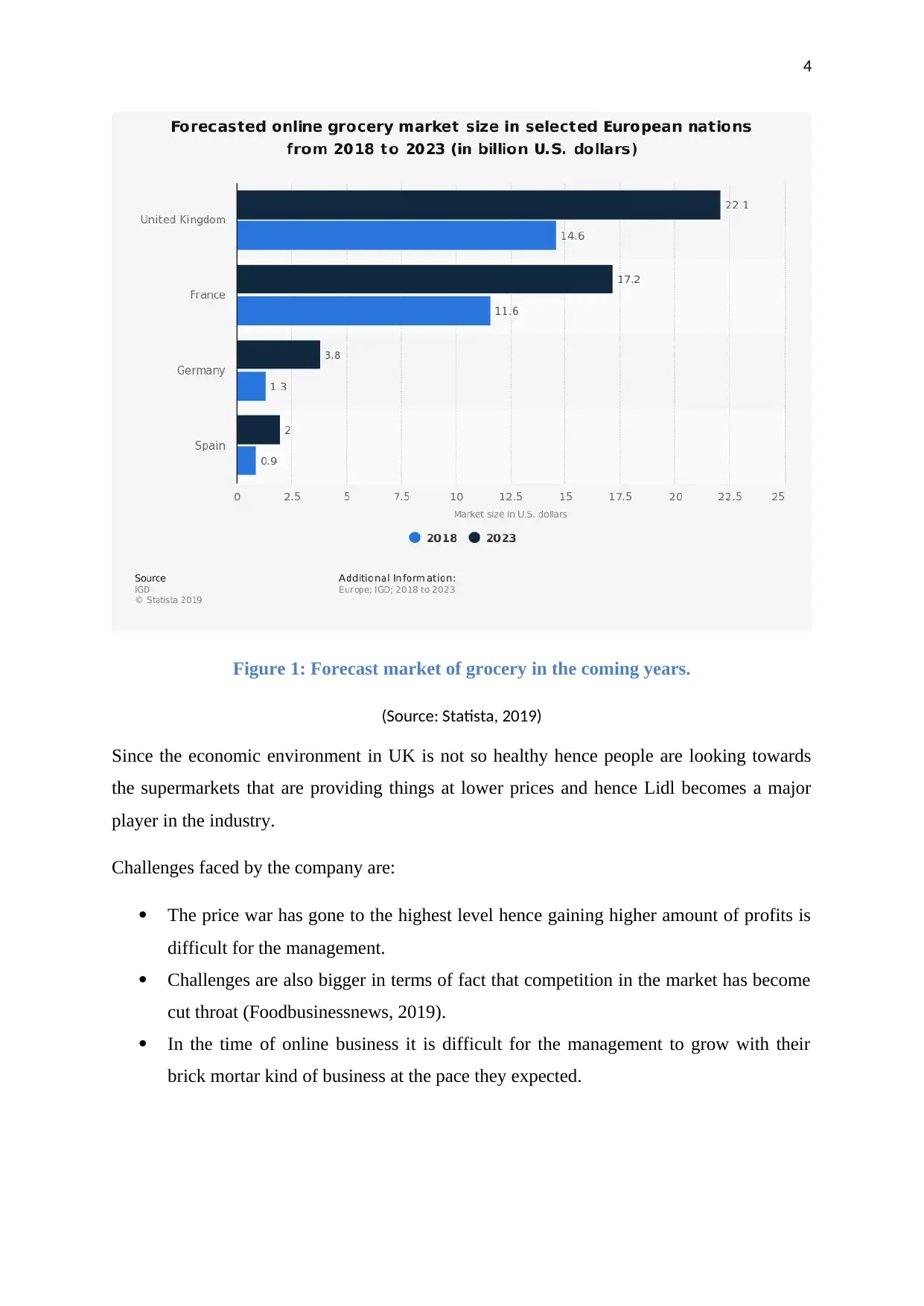
4
Figure 1: Forecast market of grocery in the coming years.
(Source: Statista, 2019)
Since the economic environment in UK is not so healthy hence people are looking towards
the supermarkets that are providing things at lower prices and hence Lidl becomes a major
player in the industry.
Challenges faced by the company are:
The price war has gone to the highest level hence gaining higher amount of profits is
difficult for the management.
Challenges are also bigger in terms of fact that competition in the market has become
cut throat (Foodbusinessnews, 2019).
In the time of online business it is difficult for the management to grow with their
brick mortar kind of business at the pace they expected.
Figure 1: Forecast market of grocery in the coming years.
(Source: Statista, 2019)
Since the economic environment in UK is not so healthy hence people are looking towards
the supermarkets that are providing things at lower prices and hence Lidl becomes a major
player in the industry.
Challenges faced by the company are:
The price war has gone to the highest level hence gaining higher amount of profits is
difficult for the management.
Challenges are also bigger in terms of fact that competition in the market has become
cut throat (Foodbusinessnews, 2019).
In the time of online business it is difficult for the management to grow with their
brick mortar kind of business at the pace they expected.
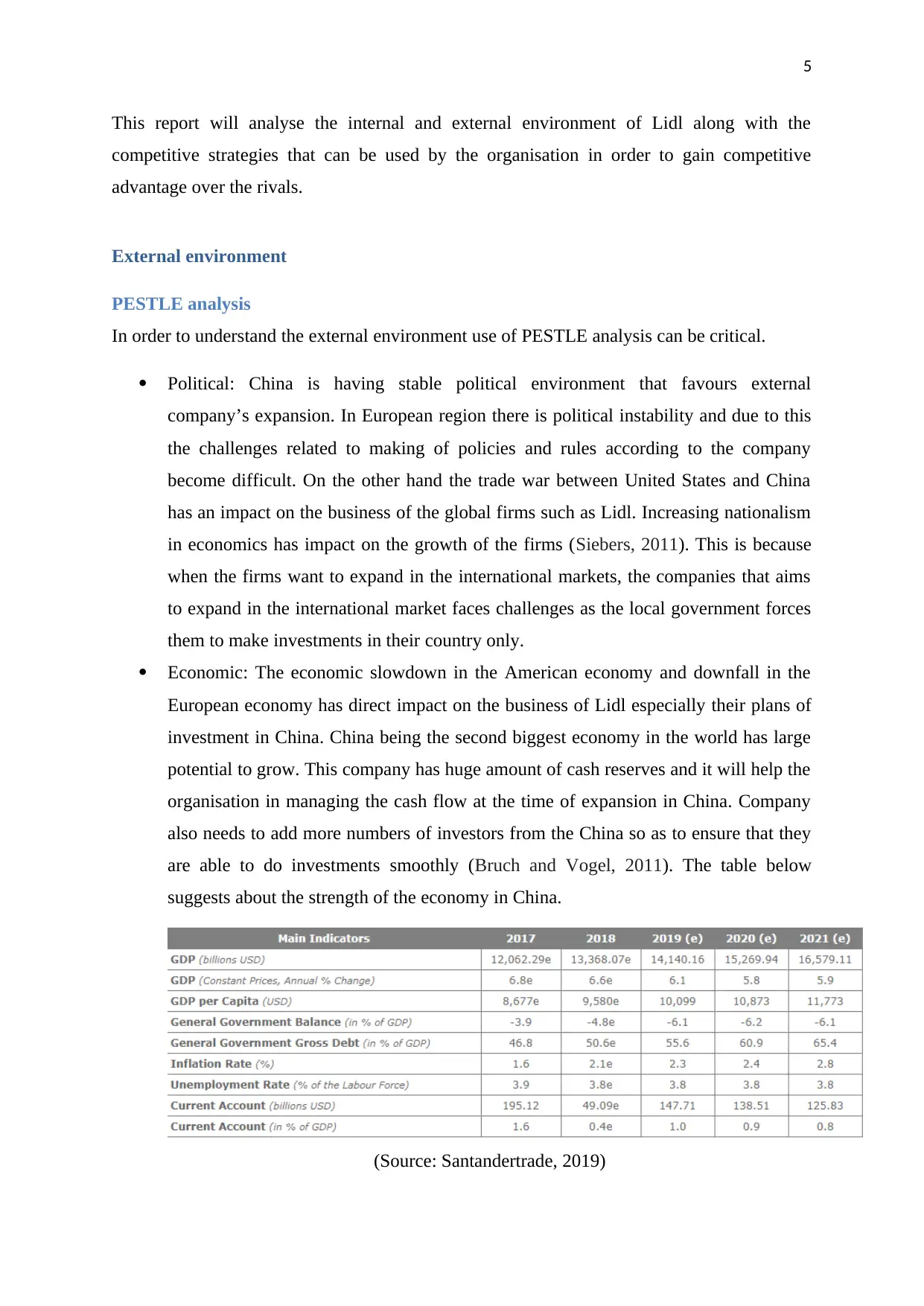
5
This report will analyse the internal and external environment of Lidl along with the
competitive strategies that can be used by the organisation in order to gain competitive
advantage over the rivals.
External environment
PESTLE analysis
In order to understand the external environment use of PESTLE analysis can be critical.
Political: China is having stable political environment that favours external
company’s expansion. In European region there is political instability and due to this
the challenges related to making of policies and rules according to the company
become difficult. On the other hand the trade war between United States and China
has an impact on the business of the global firms such as Lidl. Increasing nationalism
in economics has impact on the growth of the firms (Siebers, 2011). This is because
when the firms want to expand in the international markets, the companies that aims
to expand in the international market faces challenges as the local government forces
them to make investments in their country only.
Economic: The economic slowdown in the American economy and downfall in the
European economy has direct impact on the business of Lidl especially their plans of
investment in China. China being the second biggest economy in the world has large
potential to grow. This company has huge amount of cash reserves and it will help the
organisation in managing the cash flow at the time of expansion in China. Company
also needs to add more numbers of investors from the China so as to ensure that they
are able to do investments smoothly (Bruch and Vogel, 2011). The table below
suggests about the strength of the economy in China.
(Source: Santandertrade, 2019)
This report will analyse the internal and external environment of Lidl along with the
competitive strategies that can be used by the organisation in order to gain competitive
advantage over the rivals.
External environment
PESTLE analysis
In order to understand the external environment use of PESTLE analysis can be critical.
Political: China is having stable political environment that favours external
company’s expansion. In European region there is political instability and due to this
the challenges related to making of policies and rules according to the company
become difficult. On the other hand the trade war between United States and China
has an impact on the business of the global firms such as Lidl. Increasing nationalism
in economics has impact on the growth of the firms (Siebers, 2011). This is because
when the firms want to expand in the international markets, the companies that aims
to expand in the international market faces challenges as the local government forces
them to make investments in their country only.
Economic: The economic slowdown in the American economy and downfall in the
European economy has direct impact on the business of Lidl especially their plans of
investment in China. China being the second biggest economy in the world has large
potential to grow. This company has huge amount of cash reserves and it will help the
organisation in managing the cash flow at the time of expansion in China. Company
also needs to add more numbers of investors from the China so as to ensure that they
are able to do investments smoothly (Bruch and Vogel, 2011). The table below
suggests about the strength of the economy in China.
(Source: Santandertrade, 2019)
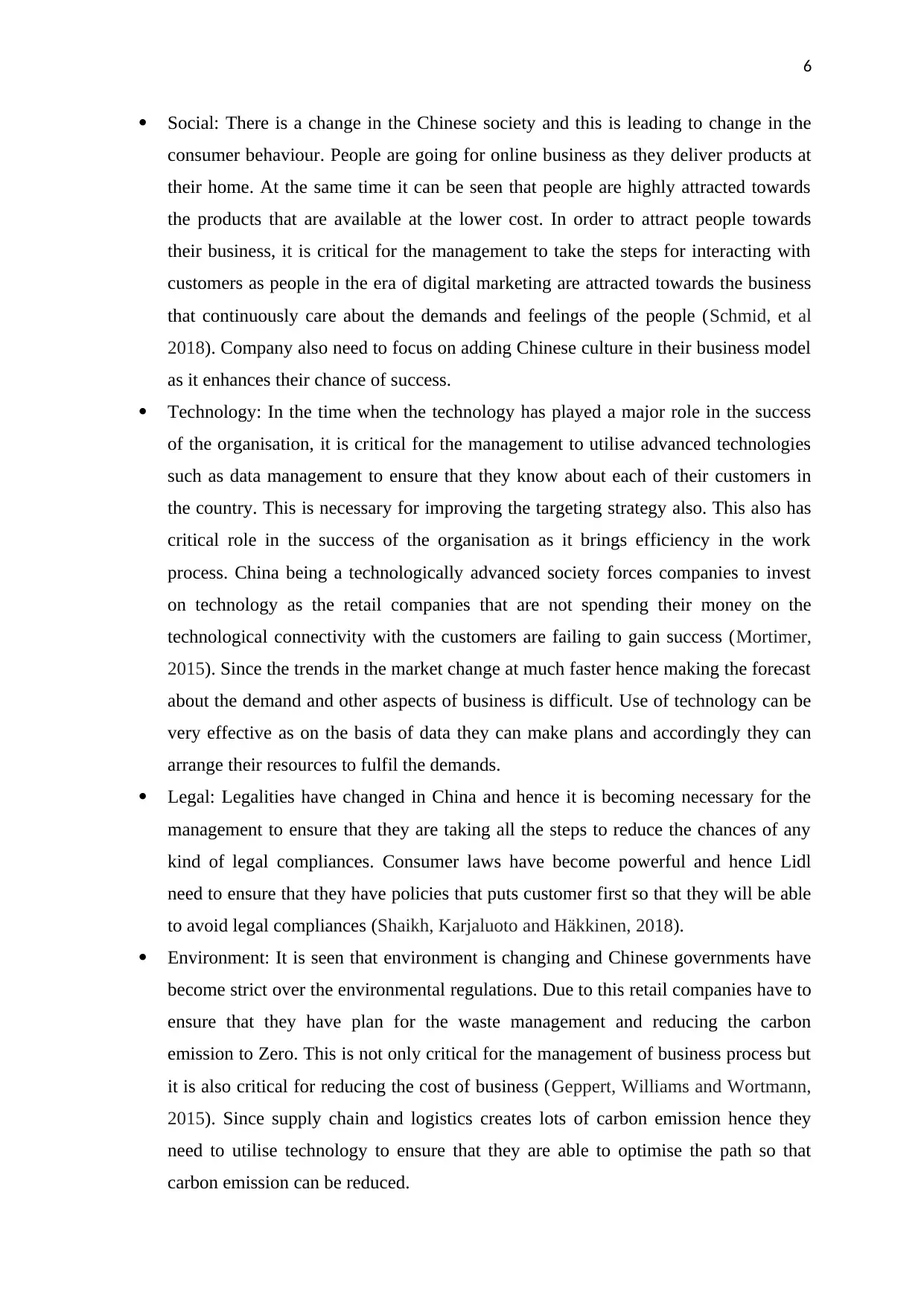
6
Social: There is a change in the Chinese society and this is leading to change in the
consumer behaviour. People are going for online business as they deliver products at
their home. At the same time it can be seen that people are highly attracted towards
the products that are available at the lower cost. In order to attract people towards
their business, it is critical for the management to take the steps for interacting with
customers as people in the era of digital marketing are attracted towards the business
that continuously care about the demands and feelings of the people (Schmid, et al
2018). Company also need to focus on adding Chinese culture in their business model
as it enhances their chance of success.
Technology: In the time when the technology has played a major role in the success
of the organisation, it is critical for the management to utilise advanced technologies
such as data management to ensure that they know about each of their customers in
the country. This is necessary for improving the targeting strategy also. This also has
critical role in the success of the organisation as it brings efficiency in the work
process. China being a technologically advanced society forces companies to invest
on technology as the retail companies that are not spending their money on the
technological connectivity with the customers are failing to gain success (Mortimer,
2015). Since the trends in the market change at much faster hence making the forecast
about the demand and other aspects of business is difficult. Use of technology can be
very effective as on the basis of data they can make plans and accordingly they can
arrange their resources to fulfil the demands.
Legal: Legalities have changed in China and hence it is becoming necessary for the
management to ensure that they are taking all the steps to reduce the chances of any
kind of legal compliances. Consumer laws have become powerful and hence Lidl
need to ensure that they have policies that puts customer first so that they will be able
to avoid legal compliances (Shaikh, Karjaluoto and Häkkinen, 2018).
Environment: It is seen that environment is changing and Chinese governments have
become strict over the environmental regulations. Due to this retail companies have to
ensure that they have plan for the waste management and reducing the carbon
emission to Zero. This is not only critical for the management of business process but
it is also critical for reducing the cost of business (Geppert, Williams and Wortmann,
2015). Since supply chain and logistics creates lots of carbon emission hence they
need to utilise technology to ensure that they are able to optimise the path so that
carbon emission can be reduced.
Social: There is a change in the Chinese society and this is leading to change in the
consumer behaviour. People are going for online business as they deliver products at
their home. At the same time it can be seen that people are highly attracted towards
the products that are available at the lower cost. In order to attract people towards
their business, it is critical for the management to take the steps for interacting with
customers as people in the era of digital marketing are attracted towards the business
that continuously care about the demands and feelings of the people (Schmid, et al
2018). Company also need to focus on adding Chinese culture in their business model
as it enhances their chance of success.
Technology: In the time when the technology has played a major role in the success
of the organisation, it is critical for the management to utilise advanced technologies
such as data management to ensure that they know about each of their customers in
the country. This is necessary for improving the targeting strategy also. This also has
critical role in the success of the organisation as it brings efficiency in the work
process. China being a technologically advanced society forces companies to invest
on technology as the retail companies that are not spending their money on the
technological connectivity with the customers are failing to gain success (Mortimer,
2015). Since the trends in the market change at much faster hence making the forecast
about the demand and other aspects of business is difficult. Use of technology can be
very effective as on the basis of data they can make plans and accordingly they can
arrange their resources to fulfil the demands.
Legal: Legalities have changed in China and hence it is becoming necessary for the
management to ensure that they are taking all the steps to reduce the chances of any
kind of legal compliances. Consumer laws have become powerful and hence Lidl
need to ensure that they have policies that puts customer first so that they will be able
to avoid legal compliances (Shaikh, Karjaluoto and Häkkinen, 2018).
Environment: It is seen that environment is changing and Chinese governments have
become strict over the environmental regulations. Due to this retail companies have to
ensure that they have plan for the waste management and reducing the carbon
emission to Zero. This is not only critical for the management of business process but
it is also critical for reducing the cost of business (Geppert, Williams and Wortmann,
2015). Since supply chain and logistics creates lots of carbon emission hence they
need to utilise technology to ensure that they are able to optimise the path so that
carbon emission can be reduced.
Paraphrase This Document
Need a fresh take? Get an instant paraphrase of this document with our AI Paraphraser
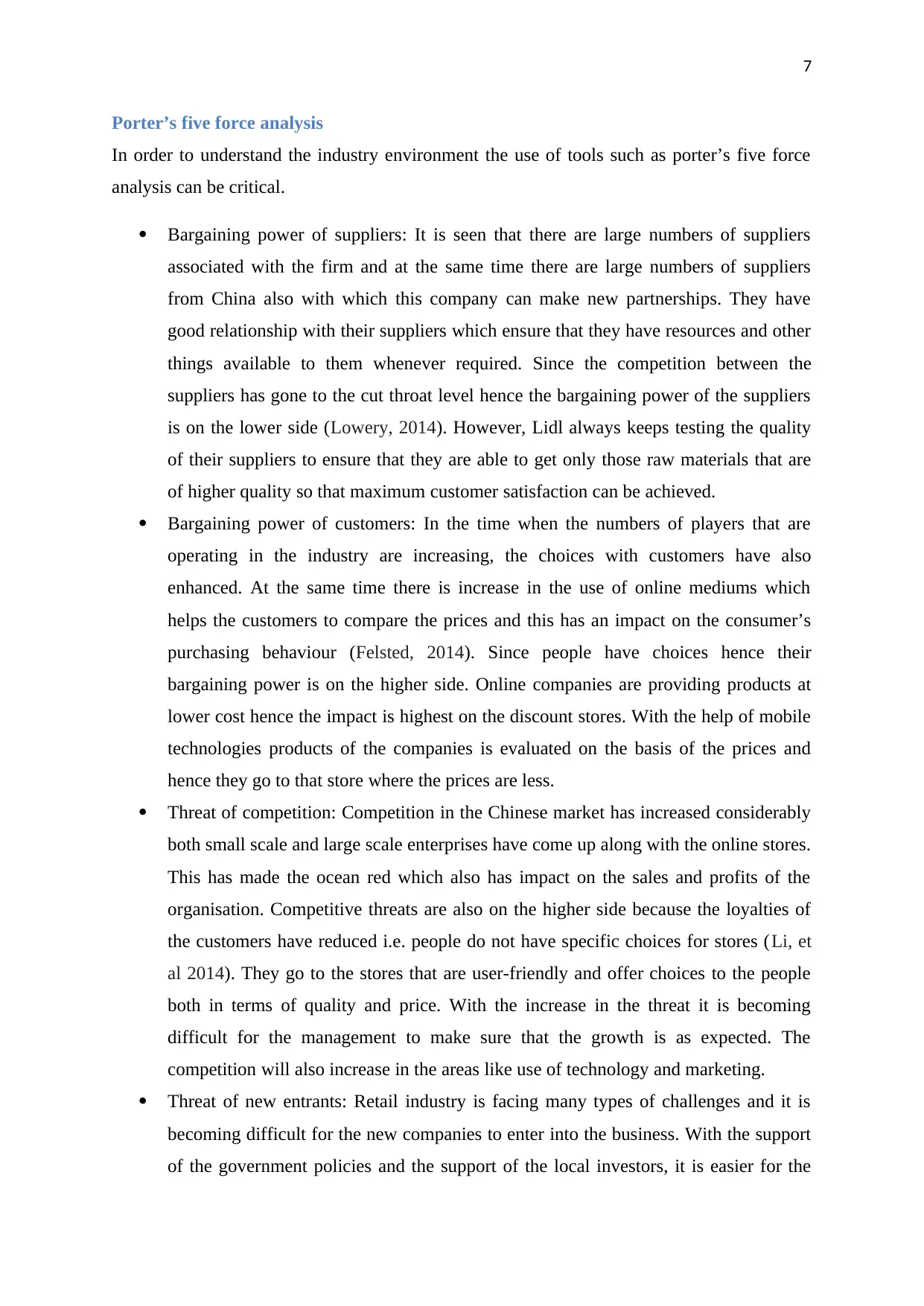
7
Porter’s five force analysis
In order to understand the industry environment the use of tools such as porter’s five force
analysis can be critical.
Bargaining power of suppliers: It is seen that there are large numbers of suppliers
associated with the firm and at the same time there are large numbers of suppliers
from China also with which this company can make new partnerships. They have
good relationship with their suppliers which ensure that they have resources and other
things available to them whenever required. Since the competition between the
suppliers has gone to the cut throat level hence the bargaining power of the suppliers
is on the lower side (Lowery, 2014). However, Lidl always keeps testing the quality
of their suppliers to ensure that they are able to get only those raw materials that are
of higher quality so that maximum customer satisfaction can be achieved.
Bargaining power of customers: In the time when the numbers of players that are
operating in the industry are increasing, the choices with customers have also
enhanced. At the same time there is increase in the use of online mediums which
helps the customers to compare the prices and this has an impact on the consumer’s
purchasing behaviour (Felsted, 2014). Since people have choices hence their
bargaining power is on the higher side. Online companies are providing products at
lower cost hence the impact is highest on the discount stores. With the help of mobile
technologies products of the companies is evaluated on the basis of the prices and
hence they go to that store where the prices are less.
Threat of competition: Competition in the Chinese market has increased considerably
both small scale and large scale enterprises have come up along with the online stores.
This has made the ocean red which also has impact on the sales and profits of the
organisation. Competitive threats are also on the higher side because the loyalties of
the customers have reduced i.e. people do not have specific choices for stores (Li, et
al 2014). They go to the stores that are user-friendly and offer choices to the people
both in terms of quality and price. With the increase in the threat it is becoming
difficult for the management to make sure that the growth is as expected. The
competition will also increase in the areas like use of technology and marketing.
Threat of new entrants: Retail industry is facing many types of challenges and it is
becoming difficult for the new companies to enter into the business. With the support
of the government policies and the support of the local investors, it is easier for the
Porter’s five force analysis
In order to understand the industry environment the use of tools such as porter’s five force
analysis can be critical.
Bargaining power of suppliers: It is seen that there are large numbers of suppliers
associated with the firm and at the same time there are large numbers of suppliers
from China also with which this company can make new partnerships. They have
good relationship with their suppliers which ensure that they have resources and other
things available to them whenever required. Since the competition between the
suppliers has gone to the cut throat level hence the bargaining power of the suppliers
is on the lower side (Lowery, 2014). However, Lidl always keeps testing the quality
of their suppliers to ensure that they are able to get only those raw materials that are
of higher quality so that maximum customer satisfaction can be achieved.
Bargaining power of customers: In the time when the numbers of players that are
operating in the industry are increasing, the choices with customers have also
enhanced. At the same time there is increase in the use of online mediums which
helps the customers to compare the prices and this has an impact on the consumer’s
purchasing behaviour (Felsted, 2014). Since people have choices hence their
bargaining power is on the higher side. Online companies are providing products at
lower cost hence the impact is highest on the discount stores. With the help of mobile
technologies products of the companies is evaluated on the basis of the prices and
hence they go to that store where the prices are less.
Threat of competition: Competition in the Chinese market has increased considerably
both small scale and large scale enterprises have come up along with the online stores.
This has made the ocean red which also has impact on the sales and profits of the
organisation. Competitive threats are also on the higher side because the loyalties of
the customers have reduced i.e. people do not have specific choices for stores (Li, et
al 2014). They go to the stores that are user-friendly and offer choices to the people
both in terms of quality and price. With the increase in the threat it is becoming
difficult for the management to make sure that the growth is as expected. The
competition will also increase in the areas like use of technology and marketing.
Threat of new entrants: Retail industry is facing many types of challenges and it is
becoming difficult for the new companies to enter into the business. With the support
of the government policies and the support of the local investors, it is easier for the
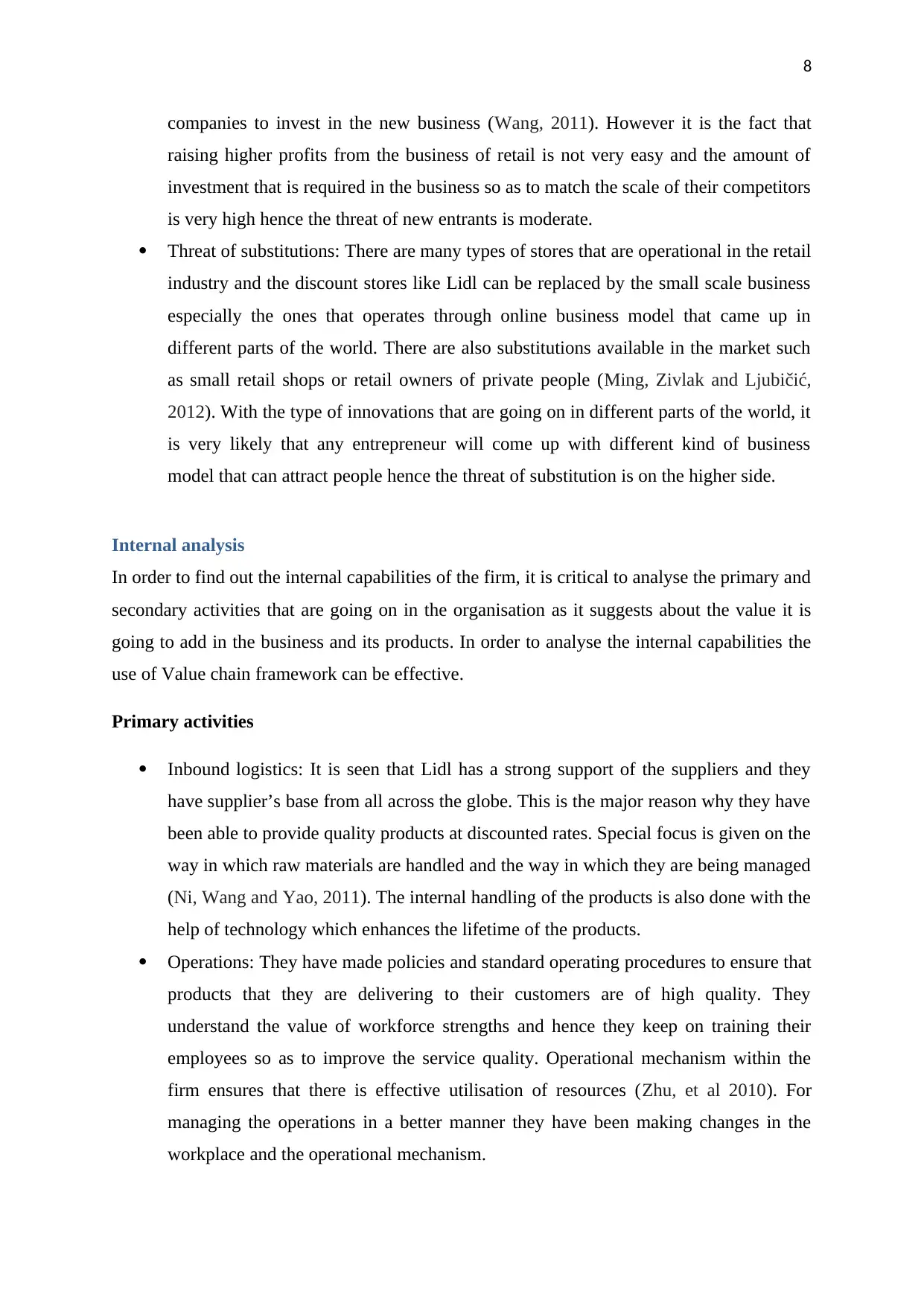
8
companies to invest in the new business (Wang, 2011). However it is the fact that
raising higher profits from the business of retail is not very easy and the amount of
investment that is required in the business so as to match the scale of their competitors
is very high hence the threat of new entrants is moderate.
Threat of substitutions: There are many types of stores that are operational in the retail
industry and the discount stores like Lidl can be replaced by the small scale business
especially the ones that operates through online business model that came up in
different parts of the world. There are also substitutions available in the market such
as small retail shops or retail owners of private people (Ming, Zivlak and Ljubičić,
2012). With the type of innovations that are going on in different parts of the world, it
is very likely that any entrepreneur will come up with different kind of business
model that can attract people hence the threat of substitution is on the higher side.
Internal analysis
In order to find out the internal capabilities of the firm, it is critical to analyse the primary and
secondary activities that are going on in the organisation as it suggests about the value it is
going to add in the business and its products. In order to analyse the internal capabilities the
use of Value chain framework can be effective.
Primary activities
Inbound logistics: It is seen that Lidl has a strong support of the suppliers and they
have supplier’s base from all across the globe. This is the major reason why they have
been able to provide quality products at discounted rates. Special focus is given on the
way in which raw materials are handled and the way in which they are being managed
(Ni, Wang and Yao, 2011). The internal handling of the products is also done with the
help of technology which enhances the lifetime of the products.
Operations: They have made policies and standard operating procedures to ensure that
products that they are delivering to their customers are of high quality. They
understand the value of workforce strengths and hence they keep on training their
employees so as to improve the service quality. Operational mechanism within the
firm ensures that there is effective utilisation of resources (Zhu, et al 2010). For
managing the operations in a better manner they have been making changes in the
workplace and the operational mechanism.
companies to invest in the new business (Wang, 2011). However it is the fact that
raising higher profits from the business of retail is not very easy and the amount of
investment that is required in the business so as to match the scale of their competitors
is very high hence the threat of new entrants is moderate.
Threat of substitutions: There are many types of stores that are operational in the retail
industry and the discount stores like Lidl can be replaced by the small scale business
especially the ones that operates through online business model that came up in
different parts of the world. There are also substitutions available in the market such
as small retail shops or retail owners of private people (Ming, Zivlak and Ljubičić,
2012). With the type of innovations that are going on in different parts of the world, it
is very likely that any entrepreneur will come up with different kind of business
model that can attract people hence the threat of substitution is on the higher side.
Internal analysis
In order to find out the internal capabilities of the firm, it is critical to analyse the primary and
secondary activities that are going on in the organisation as it suggests about the value it is
going to add in the business and its products. In order to analyse the internal capabilities the
use of Value chain framework can be effective.
Primary activities
Inbound logistics: It is seen that Lidl has a strong support of the suppliers and they
have supplier’s base from all across the globe. This is the major reason why they have
been able to provide quality products at discounted rates. Special focus is given on the
way in which raw materials are handled and the way in which they are being managed
(Ni, Wang and Yao, 2011). The internal handling of the products is also done with the
help of technology which enhances the lifetime of the products.
Operations: They have made policies and standard operating procedures to ensure that
products that they are delivering to their customers are of high quality. They
understand the value of workforce strengths and hence they keep on training their
employees so as to improve the service quality. Operational mechanism within the
firm ensures that there is effective utilisation of resources (Zhu, et al 2010). For
managing the operations in a better manner they have been making changes in the
workplace and the operational mechanism.
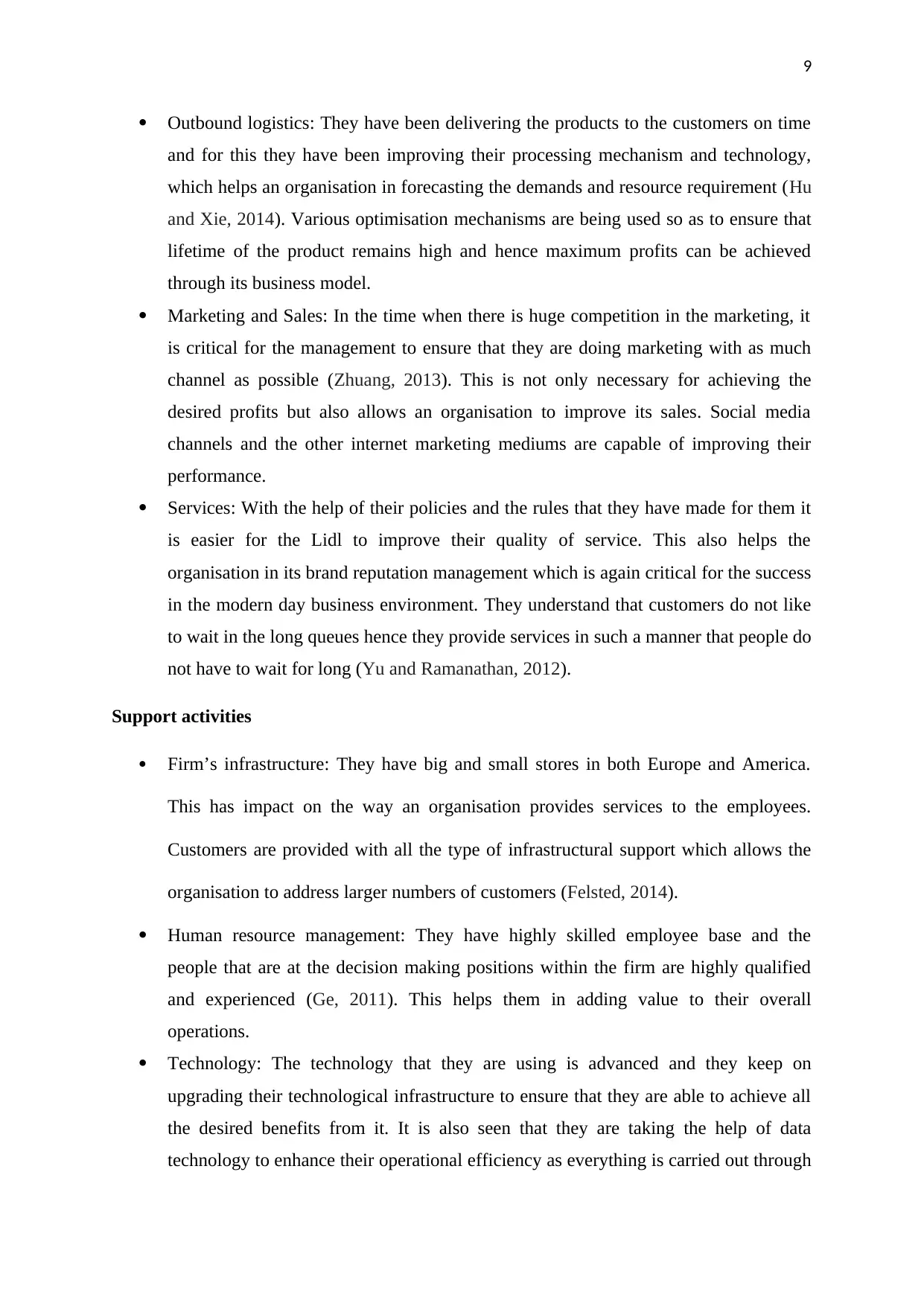
9
Outbound logistics: They have been delivering the products to the customers on time
and for this they have been improving their processing mechanism and technology,
which helps an organisation in forecasting the demands and resource requirement (Hu
and Xie, 2014). Various optimisation mechanisms are being used so as to ensure that
lifetime of the product remains high and hence maximum profits can be achieved
through its business model.
Marketing and Sales: In the time when there is huge competition in the marketing, it
is critical for the management to ensure that they are doing marketing with as much
channel as possible (Zhuang, 2013). This is not only necessary for achieving the
desired profits but also allows an organisation to improve its sales. Social media
channels and the other internet marketing mediums are capable of improving their
performance.
Services: With the help of their policies and the rules that they have made for them it
is easier for the Lidl to improve their quality of service. This also helps the
organisation in its brand reputation management which is again critical for the success
in the modern day business environment. They understand that customers do not like
to wait in the long queues hence they provide services in such a manner that people do
not have to wait for long (Yu and Ramanathan, 2012).
Support activities
Firm’s infrastructure: They have big and small stores in both Europe and America.
This has impact on the way an organisation provides services to the employees.
Customers are provided with all the type of infrastructural support which allows the
organisation to address larger numbers of customers (Felsted, 2014).
Human resource management: They have highly skilled employee base and the
people that are at the decision making positions within the firm are highly qualified
and experienced (Ge, 2011). This helps them in adding value to their overall
operations.
Technology: The technology that they are using is advanced and they keep on
upgrading their technological infrastructure to ensure that they are able to achieve all
the desired benefits from it. It is also seen that they are taking the help of data
technology to enhance their operational efficiency as everything is carried out through
Outbound logistics: They have been delivering the products to the customers on time
and for this they have been improving their processing mechanism and technology,
which helps an organisation in forecasting the demands and resource requirement (Hu
and Xie, 2014). Various optimisation mechanisms are being used so as to ensure that
lifetime of the product remains high and hence maximum profits can be achieved
through its business model.
Marketing and Sales: In the time when there is huge competition in the marketing, it
is critical for the management to ensure that they are doing marketing with as much
channel as possible (Zhuang, 2013). This is not only necessary for achieving the
desired profits but also allows an organisation to improve its sales. Social media
channels and the other internet marketing mediums are capable of improving their
performance.
Services: With the help of their policies and the rules that they have made for them it
is easier for the Lidl to improve their quality of service. This also helps the
organisation in its brand reputation management which is again critical for the success
in the modern day business environment. They understand that customers do not like
to wait in the long queues hence they provide services in such a manner that people do
not have to wait for long (Yu and Ramanathan, 2012).
Support activities
Firm’s infrastructure: They have big and small stores in both Europe and America.
This has impact on the way an organisation provides services to the employees.
Customers are provided with all the type of infrastructural support which allows the
organisation to address larger numbers of customers (Felsted, 2014).
Human resource management: They have highly skilled employee base and the
people that are at the decision making positions within the firm are highly qualified
and experienced (Ge, 2011). This helps them in adding value to their overall
operations.
Technology: The technology that they are using is advanced and they keep on
upgrading their technological infrastructure to ensure that they are able to achieve all
the desired benefits from it. It is also seen that they are taking the help of data
technology to enhance their operational efficiency as everything is carried out through
Secure Best Marks with AI Grader
Need help grading? Try our AI Grader for instant feedback on your assignments.
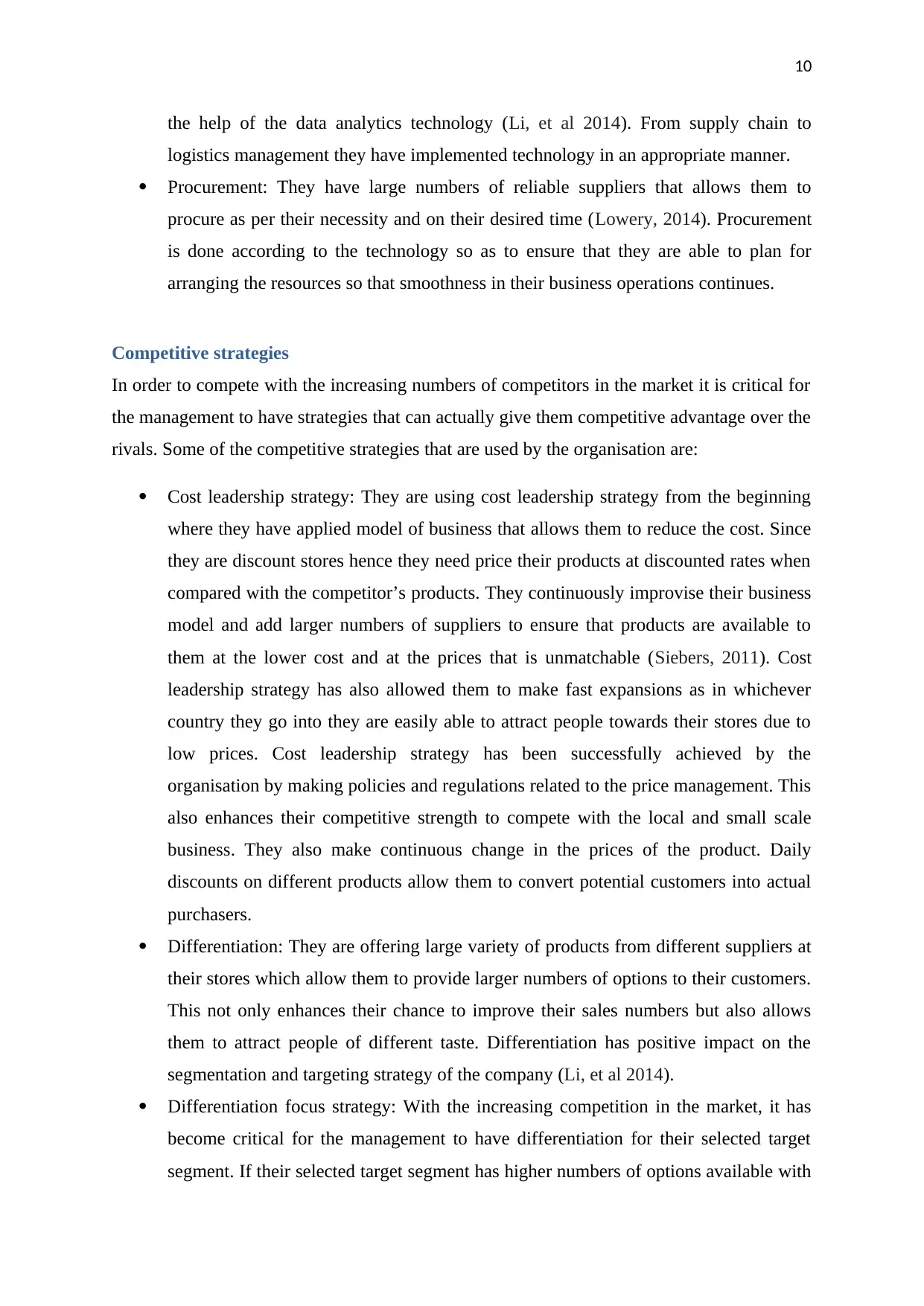
10
the help of the data analytics technology (Li, et al 2014). From supply chain to
logistics management they have implemented technology in an appropriate manner.
Procurement: They have large numbers of reliable suppliers that allows them to
procure as per their necessity and on their desired time (Lowery, 2014). Procurement
is done according to the technology so as to ensure that they are able to plan for
arranging the resources so that smoothness in their business operations continues.
Competitive strategies
In order to compete with the increasing numbers of competitors in the market it is critical for
the management to have strategies that can actually give them competitive advantage over the
rivals. Some of the competitive strategies that are used by the organisation are:
Cost leadership strategy: They are using cost leadership strategy from the beginning
where they have applied model of business that allows them to reduce the cost. Since
they are discount stores hence they need price their products at discounted rates when
compared with the competitor’s products. They continuously improvise their business
model and add larger numbers of suppliers to ensure that products are available to
them at the lower cost and at the prices that is unmatchable (Siebers, 2011). Cost
leadership strategy has also allowed them to make fast expansions as in whichever
country they go into they are easily able to attract people towards their stores due to
low prices. Cost leadership strategy has been successfully achieved by the
organisation by making policies and regulations related to the price management. This
also enhances their competitive strength to compete with the local and small scale
business. They also make continuous change in the prices of the product. Daily
discounts on different products allow them to convert potential customers into actual
purchasers.
Differentiation: They are offering large variety of products from different suppliers at
their stores which allow them to provide larger numbers of options to their customers.
This not only enhances their chance to improve their sales numbers but also allows
them to attract people of different taste. Differentiation has positive impact on the
segmentation and targeting strategy of the company (Li, et al 2014).
Differentiation focus strategy: With the increasing competition in the market, it has
become critical for the management to have differentiation for their selected target
segment. If their selected target segment has higher numbers of options available with
the help of the data analytics technology (Li, et al 2014). From supply chain to
logistics management they have implemented technology in an appropriate manner.
Procurement: They have large numbers of reliable suppliers that allows them to
procure as per their necessity and on their desired time (Lowery, 2014). Procurement
is done according to the technology so as to ensure that they are able to plan for
arranging the resources so that smoothness in their business operations continues.
Competitive strategies
In order to compete with the increasing numbers of competitors in the market it is critical for
the management to have strategies that can actually give them competitive advantage over the
rivals. Some of the competitive strategies that are used by the organisation are:
Cost leadership strategy: They are using cost leadership strategy from the beginning
where they have applied model of business that allows them to reduce the cost. Since
they are discount stores hence they need price their products at discounted rates when
compared with the competitor’s products. They continuously improvise their business
model and add larger numbers of suppliers to ensure that products are available to
them at the lower cost and at the prices that is unmatchable (Siebers, 2011). Cost
leadership strategy has also allowed them to make fast expansions as in whichever
country they go into they are easily able to attract people towards their stores due to
low prices. Cost leadership strategy has been successfully achieved by the
organisation by making policies and regulations related to the price management. This
also enhances their competitive strength to compete with the local and small scale
business. They also make continuous change in the prices of the product. Daily
discounts on different products allow them to convert potential customers into actual
purchasers.
Differentiation: They are offering large variety of products from different suppliers at
their stores which allow them to provide larger numbers of options to their customers.
This not only enhances their chance to improve their sales numbers but also allows
them to attract people of different taste. Differentiation has positive impact on the
segmentation and targeting strategy of the company (Li, et al 2014).
Differentiation focus strategy: With the increasing competition in the market, it has
become critical for the management to have differentiation for their selected target
segment. If their selected target segment has higher numbers of options available with
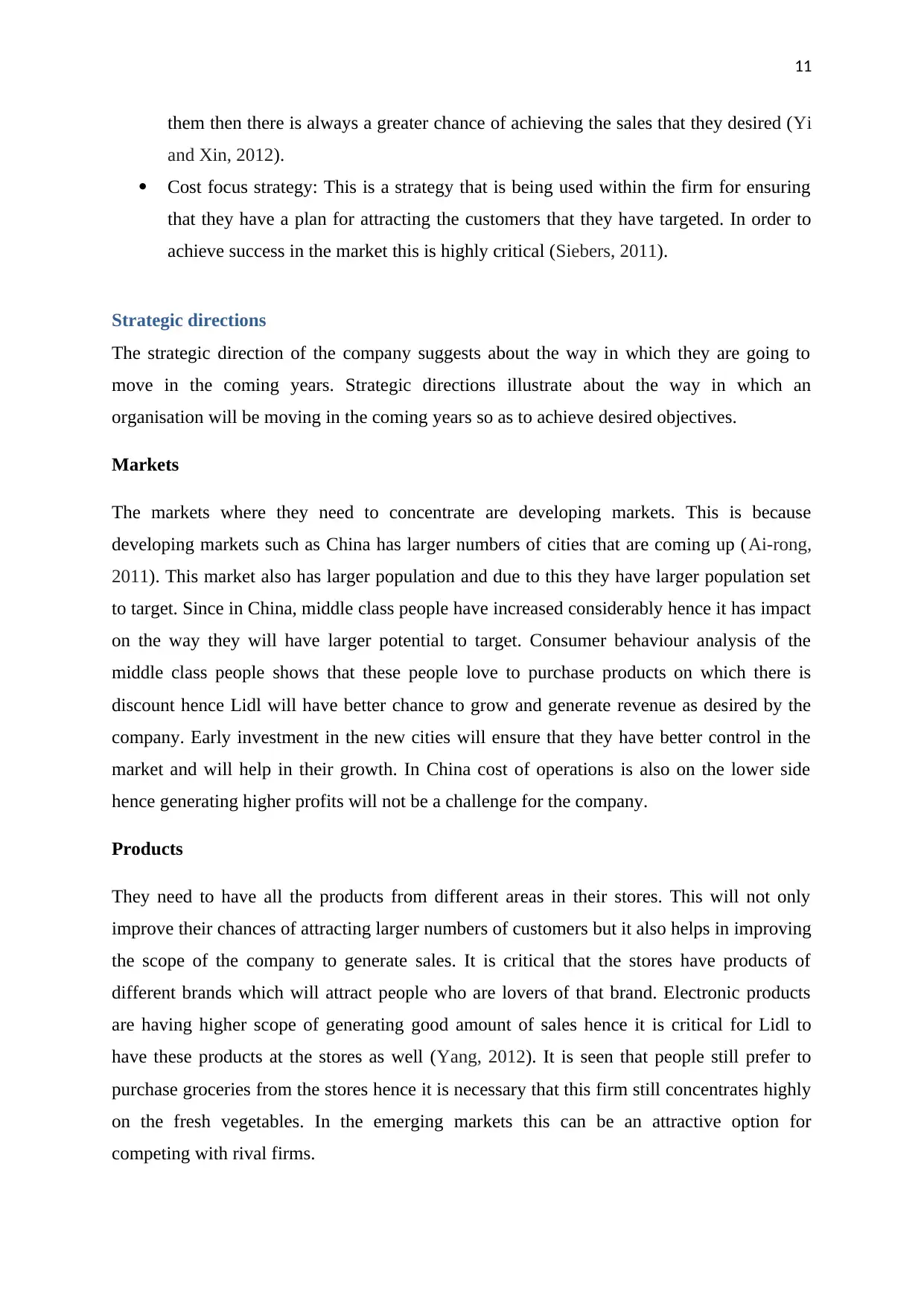
11
them then there is always a greater chance of achieving the sales that they desired (Yi
and Xin, 2012).
Cost focus strategy: This is a strategy that is being used within the firm for ensuring
that they have a plan for attracting the customers that they have targeted. In order to
achieve success in the market this is highly critical (Siebers, 2011).
Strategic directions
The strategic direction of the company suggests about the way in which they are going to
move in the coming years. Strategic directions illustrate about the way in which an
organisation will be moving in the coming years so as to achieve desired objectives.
Markets
The markets where they need to concentrate are developing markets. This is because
developing markets such as China has larger numbers of cities that are coming up (Ai-rong,
2011). This market also has larger population and due to this they have larger population set
to target. Since in China, middle class people have increased considerably hence it has impact
on the way they will have larger potential to target. Consumer behaviour analysis of the
middle class people shows that these people love to purchase products on which there is
discount hence Lidl will have better chance to grow and generate revenue as desired by the
company. Early investment in the new cities will ensure that they have better control in the
market and will help in their growth. In China cost of operations is also on the lower side
hence generating higher profits will not be a challenge for the company.
Products
They need to have all the products from different areas in their stores. This will not only
improve their chances of attracting larger numbers of customers but it also helps in improving
the scope of the company to generate sales. It is critical that the stores have products of
different brands which will attract people who are lovers of that brand. Electronic products
are having higher scope of generating good amount of sales hence it is critical for Lidl to
have these products at the stores as well (Yang, 2012). It is seen that people still prefer to
purchase groceries from the stores hence it is necessary that this firm still concentrates highly
on the fresh vegetables. In the emerging markets this can be an attractive option for
competing with rival firms.
them then there is always a greater chance of achieving the sales that they desired (Yi
and Xin, 2012).
Cost focus strategy: This is a strategy that is being used within the firm for ensuring
that they have a plan for attracting the customers that they have targeted. In order to
achieve success in the market this is highly critical (Siebers, 2011).
Strategic directions
The strategic direction of the company suggests about the way in which they are going to
move in the coming years. Strategic directions illustrate about the way in which an
organisation will be moving in the coming years so as to achieve desired objectives.
Markets
The markets where they need to concentrate are developing markets. This is because
developing markets such as China has larger numbers of cities that are coming up (Ai-rong,
2011). This market also has larger population and due to this they have larger population set
to target. Since in China, middle class people have increased considerably hence it has impact
on the way they will have larger potential to target. Consumer behaviour analysis of the
middle class people shows that these people love to purchase products on which there is
discount hence Lidl will have better chance to grow and generate revenue as desired by the
company. Early investment in the new cities will ensure that they have better control in the
market and will help in their growth. In China cost of operations is also on the lower side
hence generating higher profits will not be a challenge for the company.
Products
They need to have all the products from different areas in their stores. This will not only
improve their chances of attracting larger numbers of customers but it also helps in improving
the scope of the company to generate sales. It is critical that the stores have products of
different brands which will attract people who are lovers of that brand. Electronic products
are having higher scope of generating good amount of sales hence it is critical for Lidl to
have these products at the stores as well (Yang, 2012). It is seen that people still prefer to
purchase groceries from the stores hence it is necessary that this firm still concentrates highly
on the fresh vegetables. In the emerging markets this can be an attractive option for
competing with rival firms.
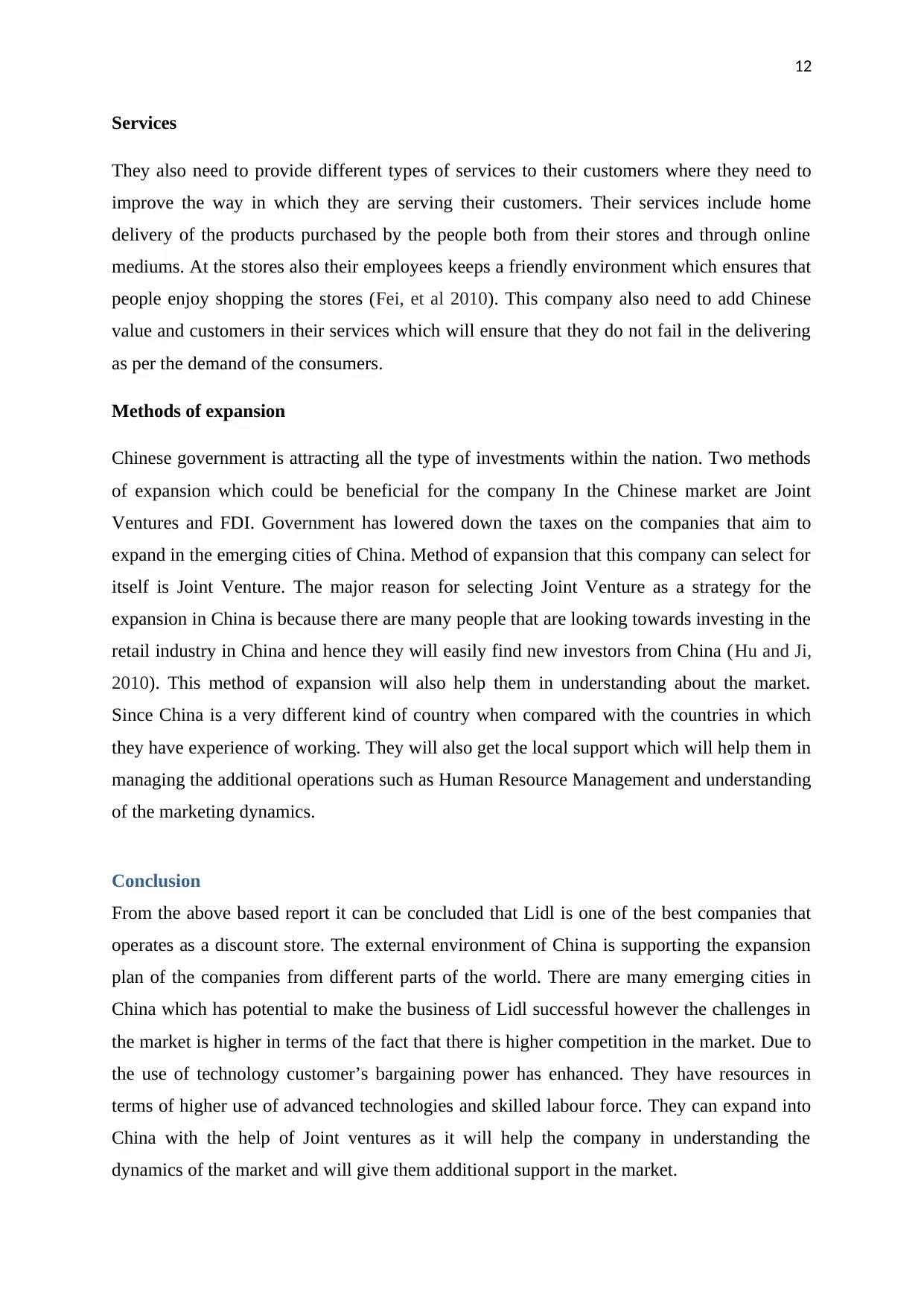
12
Services
They also need to provide different types of services to their customers where they need to
improve the way in which they are serving their customers. Their services include home
delivery of the products purchased by the people both from their stores and through online
mediums. At the stores also their employees keeps a friendly environment which ensures that
people enjoy shopping the stores (Fei, et al 2010). This company also need to add Chinese
value and customers in their services which will ensure that they do not fail in the delivering
as per the demand of the consumers.
Methods of expansion
Chinese government is attracting all the type of investments within the nation. Two methods
of expansion which could be beneficial for the company In the Chinese market are Joint
Ventures and FDI. Government has lowered down the taxes on the companies that aim to
expand in the emerging cities of China. Method of expansion that this company can select for
itself is Joint Venture. The major reason for selecting Joint Venture as a strategy for the
expansion in China is because there are many people that are looking towards investing in the
retail industry in China and hence they will easily find new investors from China (Hu and Ji,
2010). This method of expansion will also help them in understanding about the market.
Since China is a very different kind of country when compared with the countries in which
they have experience of working. They will also get the local support which will help them in
managing the additional operations such as Human Resource Management and understanding
of the marketing dynamics.
Conclusion
From the above based report it can be concluded that Lidl is one of the best companies that
operates as a discount store. The external environment of China is supporting the expansion
plan of the companies from different parts of the world. There are many emerging cities in
China which has potential to make the business of Lidl successful however the challenges in
the market is higher in terms of the fact that there is higher competition in the market. Due to
the use of technology customer’s bargaining power has enhanced. They have resources in
terms of higher use of advanced technologies and skilled labour force. They can expand into
China with the help of Joint ventures as it will help the company in understanding the
dynamics of the market and will give them additional support in the market.
Services
They also need to provide different types of services to their customers where they need to
improve the way in which they are serving their customers. Their services include home
delivery of the products purchased by the people both from their stores and through online
mediums. At the stores also their employees keeps a friendly environment which ensures that
people enjoy shopping the stores (Fei, et al 2010). This company also need to add Chinese
value and customers in their services which will ensure that they do not fail in the delivering
as per the demand of the consumers.
Methods of expansion
Chinese government is attracting all the type of investments within the nation. Two methods
of expansion which could be beneficial for the company In the Chinese market are Joint
Ventures and FDI. Government has lowered down the taxes on the companies that aim to
expand in the emerging cities of China. Method of expansion that this company can select for
itself is Joint Venture. The major reason for selecting Joint Venture as a strategy for the
expansion in China is because there are many people that are looking towards investing in the
retail industry in China and hence they will easily find new investors from China (Hu and Ji,
2010). This method of expansion will also help them in understanding about the market.
Since China is a very different kind of country when compared with the countries in which
they have experience of working. They will also get the local support which will help them in
managing the additional operations such as Human Resource Management and understanding
of the marketing dynamics.
Conclusion
From the above based report it can be concluded that Lidl is one of the best companies that
operates as a discount store. The external environment of China is supporting the expansion
plan of the companies from different parts of the world. There are many emerging cities in
China which has potential to make the business of Lidl successful however the challenges in
the market is higher in terms of the fact that there is higher competition in the market. Due to
the use of technology customer’s bargaining power has enhanced. They have resources in
terms of higher use of advanced technologies and skilled labour force. They can expand into
China with the help of Joint ventures as it will help the company in understanding the
dynamics of the market and will give them additional support in the market.
Paraphrase This Document
Need a fresh take? Get an instant paraphrase of this document with our AI Paraphraser

13
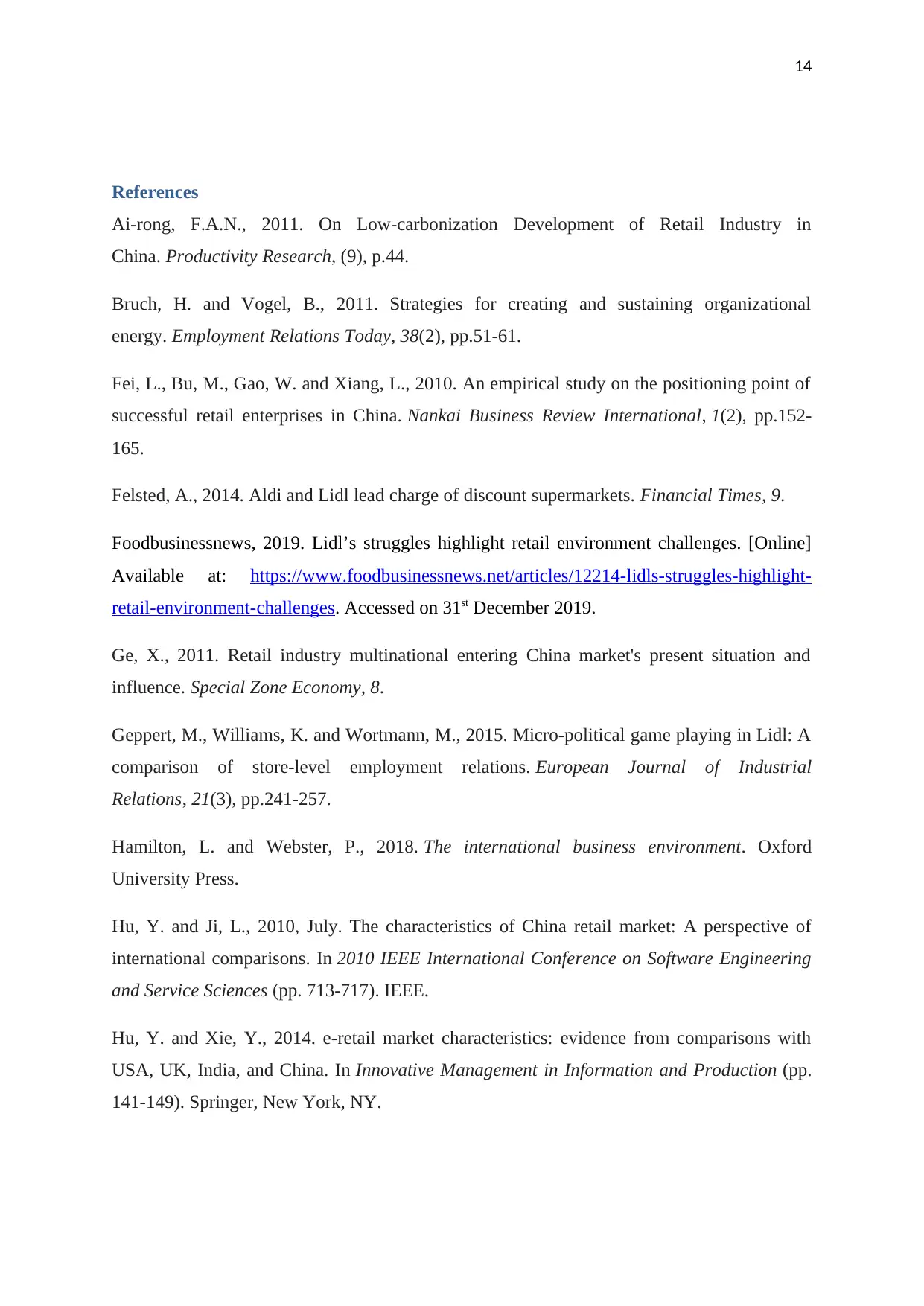
14
References
Ai-rong, F.A.N., 2011. On Low-carbonization Development of Retail Industry in
China. Productivity Research, (9), p.44.
Bruch, H. and Vogel, B., 2011. Strategies for creating and sustaining organizational
energy. Employment Relations Today, 38(2), pp.51-61.
Fei, L., Bu, M., Gao, W. and Xiang, L., 2010. An empirical study on the positioning point of
successful retail enterprises in China. Nankai Business Review International, 1(2), pp.152-
165.
Felsted, A., 2014. Aldi and Lidl lead charge of discount supermarkets. Financial Times, 9.
Foodbusinessnews, 2019. Lidl’s struggles highlight retail environment challenges. [Online]
Available at: https://www.foodbusinessnews.net/articles/12214-lidls-struggles-highlight-
retail-environment-challenges. Accessed on 31st December 2019.
Ge, X., 2011. Retail industry multinational entering China market's present situation and
influence. Special Zone Economy, 8.
Geppert, M., Williams, K. and Wortmann, M., 2015. Micro-political game playing in Lidl: A
comparison of store-level employment relations. European Journal of Industrial
Relations, 21(3), pp.241-257.
Hamilton, L. and Webster, P., 2018. The international business environment. Oxford
University Press.
Hu, Y. and Ji, L., 2010, July. The characteristics of China retail market: A perspective of
international comparisons. In 2010 IEEE International Conference on Software Engineering
and Service Sciences (pp. 713-717). IEEE.
Hu, Y. and Xie, Y., 2014. e-retail market characteristics: evidence from comparisons with
USA, UK, India, and China. In Innovative Management in Information and Production (pp.
141-149). Springer, New York, NY.
References
Ai-rong, F.A.N., 2011. On Low-carbonization Development of Retail Industry in
China. Productivity Research, (9), p.44.
Bruch, H. and Vogel, B., 2011. Strategies for creating and sustaining organizational
energy. Employment Relations Today, 38(2), pp.51-61.
Fei, L., Bu, M., Gao, W. and Xiang, L., 2010. An empirical study on the positioning point of
successful retail enterprises in China. Nankai Business Review International, 1(2), pp.152-
165.
Felsted, A., 2014. Aldi and Lidl lead charge of discount supermarkets. Financial Times, 9.
Foodbusinessnews, 2019. Lidl’s struggles highlight retail environment challenges. [Online]
Available at: https://www.foodbusinessnews.net/articles/12214-lidls-struggles-highlight-
retail-environment-challenges. Accessed on 31st December 2019.
Ge, X., 2011. Retail industry multinational entering China market's present situation and
influence. Special Zone Economy, 8.
Geppert, M., Williams, K. and Wortmann, M., 2015. Micro-political game playing in Lidl: A
comparison of store-level employment relations. European Journal of Industrial
Relations, 21(3), pp.241-257.
Hamilton, L. and Webster, P., 2018. The international business environment. Oxford
University Press.
Hu, Y. and Ji, L., 2010, July. The characteristics of China retail market: A perspective of
international comparisons. In 2010 IEEE International Conference on Software Engineering
and Service Sciences (pp. 713-717). IEEE.
Hu, Y. and Xie, Y., 2014. e-retail market characteristics: evidence from comparisons with
USA, UK, India, and China. In Innovative Management in Information and Production (pp.
141-149). Springer, New York, NY.
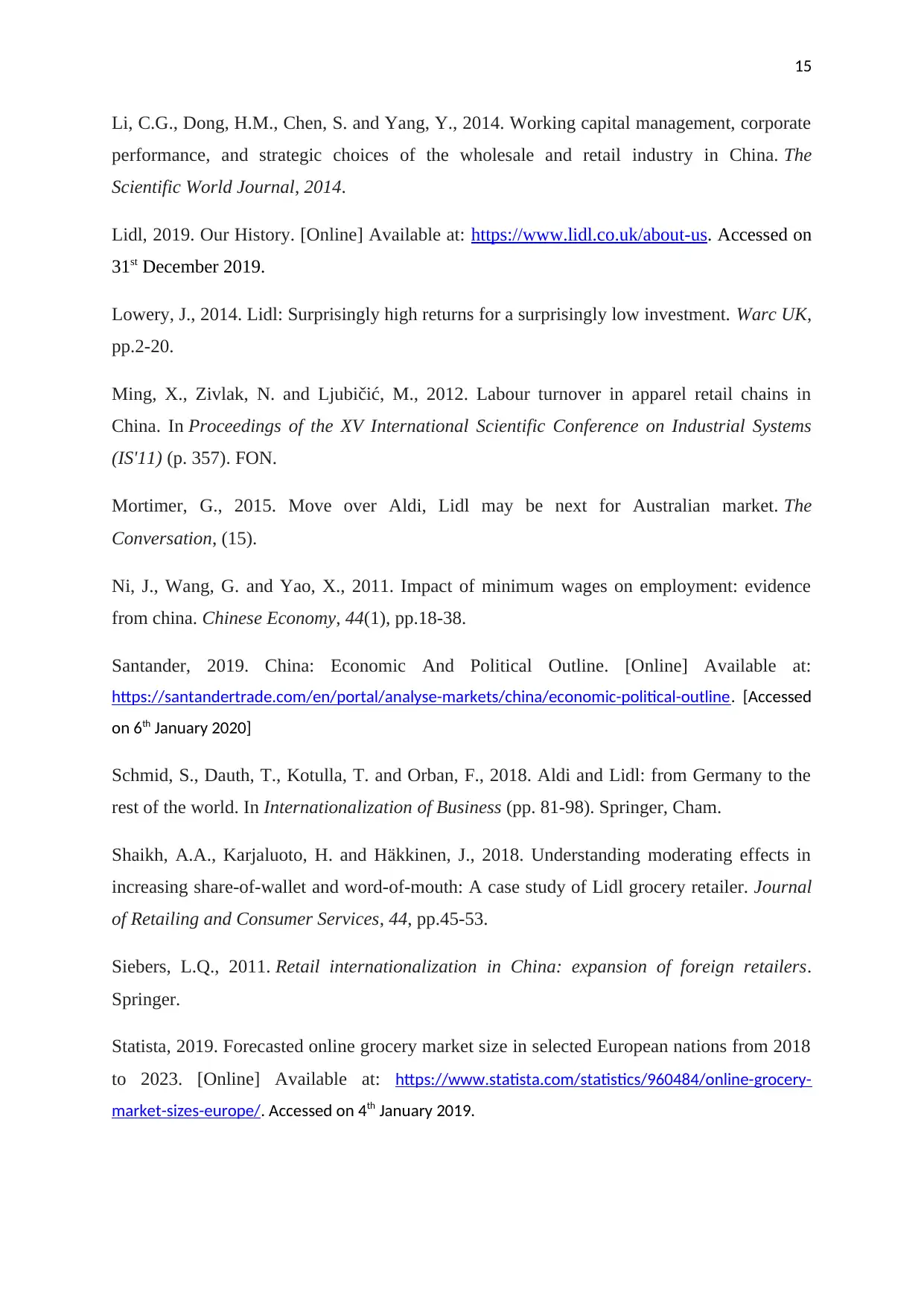
15
Li, C.G., Dong, H.M., Chen, S. and Yang, Y., 2014. Working capital management, corporate
performance, and strategic choices of the wholesale and retail industry in China. The
Scientific World Journal, 2014.
Lidl, 2019. Our History. [Online] Available at: https://www.lidl.co.uk/about-us. Accessed on
31st December 2019.
Lowery, J., 2014. Lidl: Surprisingly high returns for a surprisingly low investment. Warc UK,
pp.2-20.
Ming, X., Zivlak, N. and Ljubičić, M., 2012. Labour turnover in apparel retail chains in
China. In Proceedings of the XV International Scientific Conference on Industrial Systems
(IS'11) (p. 357). FON.
Mortimer, G., 2015. Move over Aldi, Lidl may be next for Australian market. The
Conversation, (15).
Ni, J., Wang, G. and Yao, X., 2011. Impact of minimum wages on employment: evidence
from china. Chinese Economy, 44(1), pp.18-38.
Santander, 2019. China: Economic And Political Outline. [Online] Available at:
https://santandertrade.com/en/portal/analyse-markets/china/economic-political-outline. [Accessed
on 6th January 2020]
Schmid, S., Dauth, T., Kotulla, T. and Orban, F., 2018. Aldi and Lidl: from Germany to the
rest of the world. In Internationalization of Business (pp. 81-98). Springer, Cham.
Shaikh, A.A., Karjaluoto, H. and Häkkinen, J., 2018. Understanding moderating effects in
increasing share-of-wallet and word-of-mouth: A case study of Lidl grocery retailer. Journal
of Retailing and Consumer Services, 44, pp.45-53.
Siebers, L.Q., 2011. Retail internationalization in China: expansion of foreign retailers.
Springer.
Statista, 2019. Forecasted online grocery market size in selected European nations from 2018
to 2023. [Online] Available at: https://www.statista.com/statistics/960484/online-grocery-
market-sizes-europe/. Accessed on 4th January 2019.
Li, C.G., Dong, H.M., Chen, S. and Yang, Y., 2014. Working capital management, corporate
performance, and strategic choices of the wholesale and retail industry in China. The
Scientific World Journal, 2014.
Lidl, 2019. Our History. [Online] Available at: https://www.lidl.co.uk/about-us. Accessed on
31st December 2019.
Lowery, J., 2014. Lidl: Surprisingly high returns for a surprisingly low investment. Warc UK,
pp.2-20.
Ming, X., Zivlak, N. and Ljubičić, M., 2012. Labour turnover in apparel retail chains in
China. In Proceedings of the XV International Scientific Conference on Industrial Systems
(IS'11) (p. 357). FON.
Mortimer, G., 2015. Move over Aldi, Lidl may be next for Australian market. The
Conversation, (15).
Ni, J., Wang, G. and Yao, X., 2011. Impact of minimum wages on employment: evidence
from china. Chinese Economy, 44(1), pp.18-38.
Santander, 2019. China: Economic And Political Outline. [Online] Available at:
https://santandertrade.com/en/portal/analyse-markets/china/economic-political-outline. [Accessed
on 6th January 2020]
Schmid, S., Dauth, T., Kotulla, T. and Orban, F., 2018. Aldi and Lidl: from Germany to the
rest of the world. In Internationalization of Business (pp. 81-98). Springer, Cham.
Shaikh, A.A., Karjaluoto, H. and Häkkinen, J., 2018. Understanding moderating effects in
increasing share-of-wallet and word-of-mouth: A case study of Lidl grocery retailer. Journal
of Retailing and Consumer Services, 44, pp.45-53.
Siebers, L.Q., 2011. Retail internationalization in China: expansion of foreign retailers.
Springer.
Statista, 2019. Forecasted online grocery market size in selected European nations from 2018
to 2023. [Online] Available at: https://www.statista.com/statistics/960484/online-grocery-
market-sizes-europe/. Accessed on 4th January 2019.
Secure Best Marks with AI Grader
Need help grading? Try our AI Grader for instant feedback on your assignments.
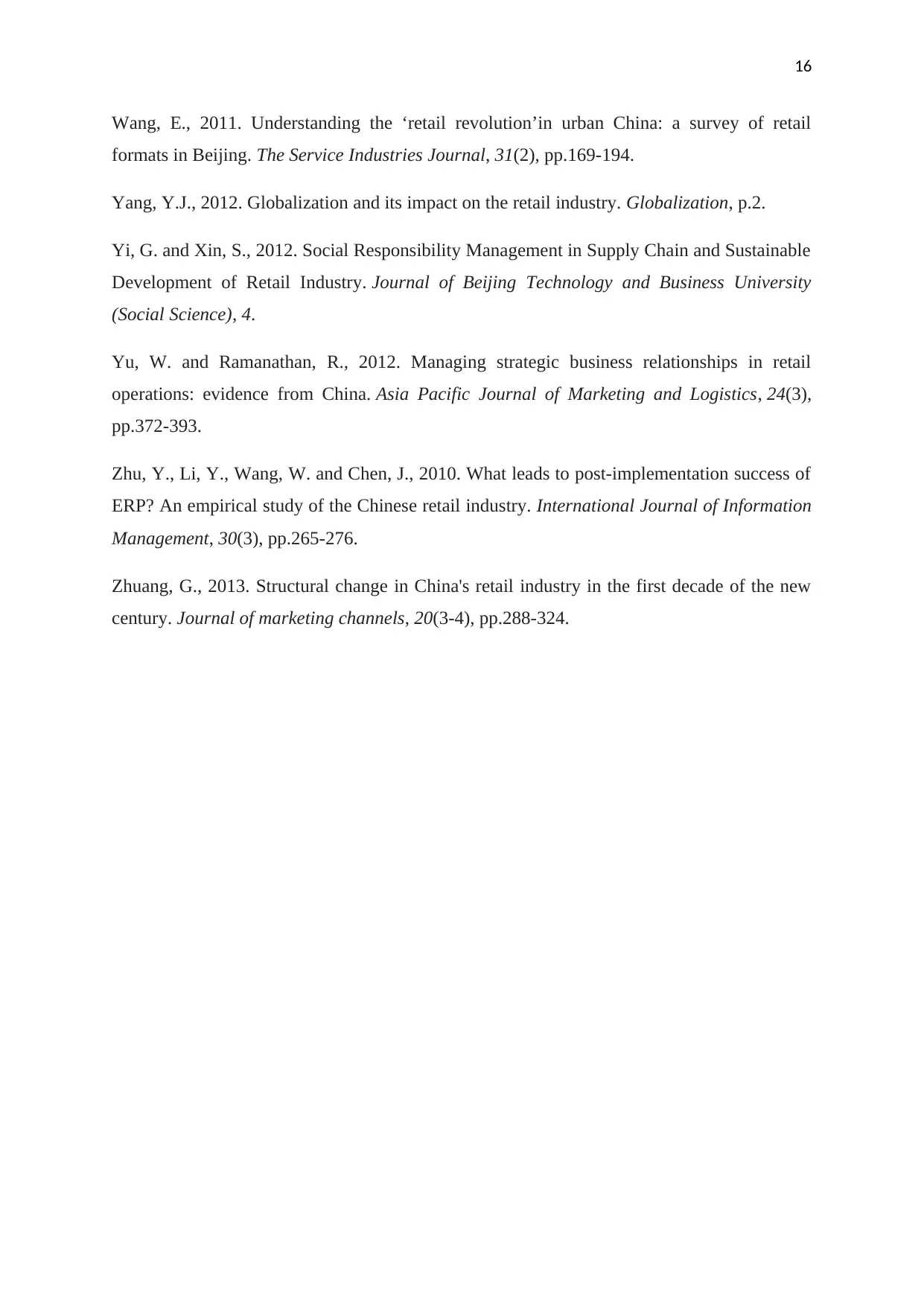
16
Wang, E., 2011. Understanding the ‘retail revolution’in urban China: a survey of retail
formats in Beijing. The Service Industries Journal, 31(2), pp.169-194.
Yang, Y.J., 2012. Globalization and its impact on the retail industry. Globalization, p.2.
Yi, G. and Xin, S., 2012. Social Responsibility Management in Supply Chain and Sustainable
Development of Retail Industry. Journal of Beijing Technology and Business University
(Social Science), 4.
Yu, W. and Ramanathan, R., 2012. Managing strategic business relationships in retail
operations: evidence from China. Asia Pacific Journal of Marketing and Logistics, 24(3),
pp.372-393.
Zhu, Y., Li, Y., Wang, W. and Chen, J., 2010. What leads to post-implementation success of
ERP? An empirical study of the Chinese retail industry. International Journal of Information
Management, 30(3), pp.265-276.
Zhuang, G., 2013. Structural change in China's retail industry in the first decade of the new
century. Journal of marketing channels, 20(3-4), pp.288-324.
Wang, E., 2011. Understanding the ‘retail revolution’in urban China: a survey of retail
formats in Beijing. The Service Industries Journal, 31(2), pp.169-194.
Yang, Y.J., 2012. Globalization and its impact on the retail industry. Globalization, p.2.
Yi, G. and Xin, S., 2012. Social Responsibility Management in Supply Chain and Sustainable
Development of Retail Industry. Journal of Beijing Technology and Business University
(Social Science), 4.
Yu, W. and Ramanathan, R., 2012. Managing strategic business relationships in retail
operations: evidence from China. Asia Pacific Journal of Marketing and Logistics, 24(3),
pp.372-393.
Zhu, Y., Li, Y., Wang, W. and Chen, J., 2010. What leads to post-implementation success of
ERP? An empirical study of the Chinese retail industry. International Journal of Information
Management, 30(3), pp.265-276.
Zhuang, G., 2013. Structural change in China's retail industry in the first decade of the new
century. Journal of marketing channels, 20(3-4), pp.288-324.
1 out of 17
Related Documents
Your All-in-One AI-Powered Toolkit for Academic Success.
+13062052269
info@desklib.com
Available 24*7 on WhatsApp / Email
![[object Object]](/_next/static/media/star-bottom.7253800d.svg)
Unlock your academic potential
© 2024 | Zucol Services PVT LTD | All rights reserved.





